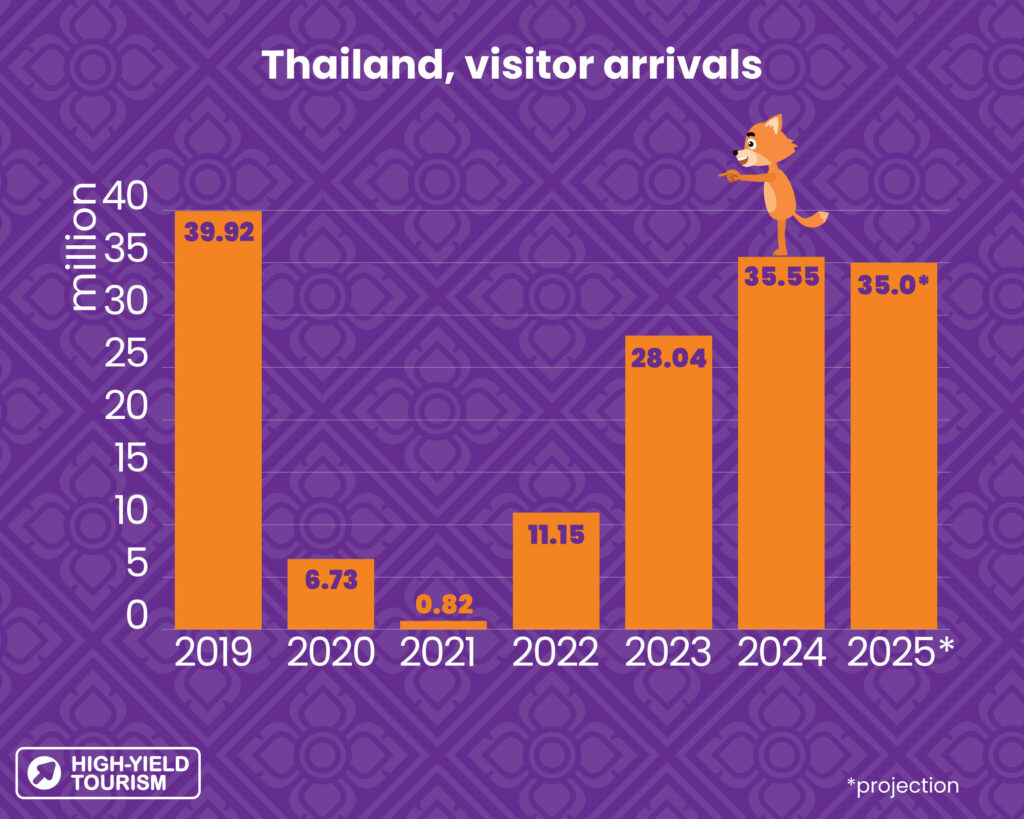Beyond the Numbers: Rethinking Thailand's Approach to Tourism
Thailand’s tourism industry is at a crucial juncture. Although international arrivals have rebounded strongly since the pandemic, they have declined compared to the figures from last year. The significant decrease in Chinese tourists, formerly the country’s largest source market, has raised concerns. Visitor numbers from China in early 2025 have dropped by 32 percent compared to the previous year. For a destination that once welcomed nearly 11 million Chinese visitors annually, this decline is more than just a statistical blip; it signifies a shift that necessitates a bold reevaluation of tourism strategies.
A Changing Landscape in Numbers
In 2024, Thailand experienced a remarkable recovery, welcoming over 35 million international tourists and generating more than 1.8 trillion Baht in revenue. However, 2025 presents a more complex picture. As of mid-year, approximately 16.61 million foreign visitors have ar
rived, marking a 4.56% decline compared to the same period in 2024. Reflecting this trend, the Bank of Thailand revised its full-year forecast downward from 37.5 million to 35 million visitors. While this still indicates solid recovery, it falls short of the pre-pandemic peak of nearly 40 million in 2019.
This slowdown, especially in Chinese arrivals, underscores the need for Thailand to rethink growth beyond mere visitor counts.

Insights from High-Yield Tourism
Gary Bowerman of High-Yield Tourism highlights in a recent article by Channel News Asia, how Chinese travelers have evolved since the pandemic. They are now more independent, value-driven, and focused on authentic experiences. “The Chinese traveler now is very different from the Chinese traveler pre-pandemic,” Bowerman notes. His insights resonate with High-Yield Tourism principles, which prioritize value, impact, and long-term resilience over mere volume.
Why High-Yield Tourism is the Right Path
High-Yield Tourism focuses on attracting travelers who contribute significantly in economic, cultural, and environmental terms. These visitors typically stay longer, spend more, explore a wider area, and return more frequently. They seek deeper engagement and are more likely to support local businesses, respect cultural heritage, and pursue experiences aligned with sustainable values.
Thailand has already begun shifting its approach. Recent initiatives by the Tourism Authority of Thailand (TAT), such as influencer campaigns like “Sawadee Nihao” and digital partnerships with platforms like Baidu, aim to target independent travelers with higher spending potential and diverse interests. Additionally, the rising number of visitors from emerging markets, such as India, which surpassed 1 million arrivals by mid-2025, demonstrates the benefits of broadening the focus beyond traditional markets.
Growth Should Be Measured in Yield, Not Just Numbers
The 32 percent year-on-year decline in Chinese visitors from January to May 2025 highlights the need to redefine what growth means for Thailand. Instead of concentrating solely on visitor counts, the country should adopt a strategic perspective centered on yield: the total economic, social, and environmental value each visitor brings.
Yield-based metrics incorporate spending per trip, length of stay, regional dispersion, repeat visits, and community benefits. This approach provides a more comprehensive and sustainable definition of success, especially in an increasingly competitive global market.
The China Market is Changing, and So Should the Strategy
The slower return of Chinese tourists reflects broader shifts in traveler behavior. Modern Chinese tourists are better informed, more discerning, and expect meaningful value for their money. They favor personalized, high-quality experiences such as culinary and wellness tourism, nature exploration, and heritage travel. These preferences align well with Thailand’s strengths but require more refined, insight-driven strategies.
As Bowerman observes, travel from China has become “more cautious and selective,” with travelers conducting more research and booking independently. This evolution calls for targeted engagement, dynamic storytelling, and tailored offerings for distinct market segments, core components of the High-Yield Tourism approach.
Toward Resilience, Not Just Recovery
The current landscape presents Thailand with an opportunity to transition from a volume-driven model to a more resilient and inclusive tourism economy. High-Yield Tourism encourages diversification across source markets, higher returns on investment per visitor, and reduced economic leakage. It also supports national goals, such as sustainability, regional development, and the preservation of cultural and natural heritage.
Rather than chasing visitor numbers, Thailand should focus on delivering exceptional quality and building visitor loyalty; strategies that cultivate stronger relationships and encourage frequent returns, resulting in a greater economic and social impact.
Conclusion: A Strategic Moment for Thailand
The slowdown in arrival numbers is not a setback but a signal and a strategic opportunity to redefine successful tourism. With its assets, talent, and a strong global profile, Thailand can lead the region in reshaping the value of tourism.
By investing in High-Yield Tourism and targeting travelers who genuinely appreciate what Thailand offers, the country can secure its tourism economy’s future, standing out not just as a top destination but as a model for sustainable, inclusive growth, where success is measured not only by visitor numbers but also by the positive impact each visit generates.
Additional Resources
- High-Yield Tourism Podcast: Episode 11 – A New Era of High-Yield Tourism in Thailand
- Channel News Asia - Why is Thai tourism stuttering and will its renewed focus on ‘quality over quantity’ work?
- TAT News - Thailand Reinforces Thai–ChineseRelations with “Sawasdee Nihao” Tourism Initiative
- Bangkok Post - Bank of Thailand slashes tourism forecast
🎧 Tune in to the High-Yield Tourism Podcast for expert insights and real-world case studies.
👉 Browse Episodes
Photo by Connor Gan on Unsplash
more insights

The AI Divide in Tourism: How Big Data Is Leaving Small Operators Behind
The AI Divide in Tourism: How Big Data Is Leaving Small Operators Behind Artificial intelligence (AI) and big data are transforming the tourism industry. From

Introducing The Strength-based Strategy Framework To Drive High-Yield Tourism
Introducing The Strength-based Strategy Framework To Drive High-Yield Tourism How an Adapted Business Model Is Revolutionizing Destination Planning: From Volume to Value soar /sɔː/verb: achieving

Beyond Boom and Bust: Rethinking Tourism Policy for Sustainable Growth
Beyond Boom and Bust: Rethinking Tourism Policy for Sustainable Growth Tourism is often hailed as a key driver of economic growth, cultural exchange, and local
High-Yield Tourism
68 Circular Road #02-01
Singapore 049422
Email: hello@highyieldtourism.com
Sign-up to receive updates about High-Yield Tourism, industry news, and reports.
